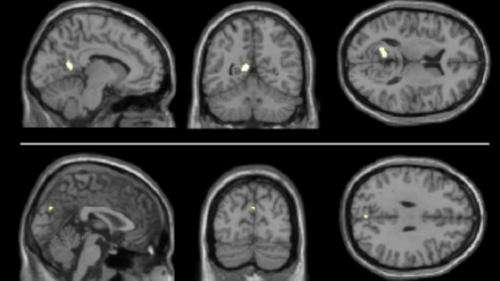Test could detect Alzheimer's disease earlier than previously possible

(Medical Xpress) -- A new study has revealed the possibility of using a simple test for the early detection of Alzheimer’s disease, enabling the condition to be identified before significant and irreversible decline takes place.
The research, carried out by a team from the University of Cambridge led by Professor Barbara Sahakian, investigated brain activation in patients with mild cognitive impairment (MCI) whilst they completed a memory task which assessed their visual perception of the spatial relationships of objects (visuospatial).
In the task, known as a paired associate learning task (PAL), the participants must remember the spatial location of up to eight different patterns hidden in boxes. For the study, the researchers conducted brain scans (or fMRIs) while the patients took the tests in order to monitor brain activity.
It was found that when asked to remember the location of low numbers of patterns, the MCI patient’s brains showed significantly more activation than the healthy, control participants, whereas, at higher levels of difficulty, the patients showed significantly lower levels of activation. These results suggest that MCI patients try to compensate for their difficulty in performing the task by increasing brain activity but when the task becomes too difficult for them to perform, their brain activity reduces.
“A major problem we find with Alzheimer’s disease is that by the time it is clinically detectable there is already a significant impairment to the sufferer. The damage has already been done and there is a huge impact on the person’s quality of life and day to day functioning,” explains Professor Sahakian. “Our research gives insight into how, and why, this test could be used to detect Alzheimer’s earlier than other current methods.”
The key area of the brain where these activations took place was the hippocampus, an area of the brain known to be affected early in Alzheimer’s disease. (Indeed, the test was originally devised to assess the ability of this area of the brain, since the hippocampus is known to be critical for learning where objects are in space.) Another discovery was that even though these MCI patients had not progressed to a diagnosis of Alzheimer’s disease as yet, they nevertheless had reduced volumetric measures in the hippocampus.
Professor Sahakian continued: “MCI is very much the precursor stage to Alzheimer’s. Indeed, seven of the twenty patients subsequently developed Alzheimer’s disease. What these results show us is that individuals with MCI have difficulty on this one particular task. This enables us to identify those who are at risk from Alzheimer’s and will hopefully allow us to halt or even prevent their decline before it becomes too severe.”
As healthcare improves and people are living longer there is a continuing rise in the prevalence of age-related cognitive disorders. There is therefore a growing and increasingly urgent need to improve detection and treatment of Alzheimer’s disease, which itself accounts for 60% of all cases of dementia. Professor Sahakian and her colleagues believe that performance on the PAL task could act as a useful preclinical marker (or ‘biomarker’) for the early detection of Alzheimer’s disease.
“What is really exciting about these results is that the PAL task is a relatively simple computer test. It doesn’t require anything elaborate nor is it difficult to administer and interpret the results. It is a straightforward, quick, non-invasive and inexpensive means of identifying those that might be at risk from Alzheimer’s prior to any significant decline,” said Professor Sahakian.
Whilst the computerised test would be useful for screening elderly people to detect those with mild cognitive impairment, when combined with neuroimaging, the PAL test may also be useful for the development of novel treatments, both pharmacological and non-pharmacological. There are currently a number of symptomatic and neuroprotective drugs in development within the pharmaceutical industry for the treatment of Alzheimer’s disease.
The findings from the study were published in the journal Neuropsychologia.
















